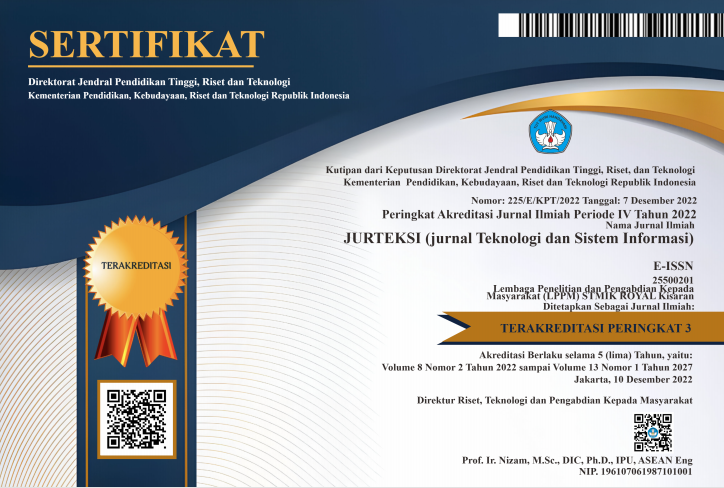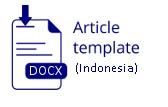DEVELOPMENT OF VIRTUAL REALITY APPLICATION FOR DESKTOP COMPUTER ASSEMBLY
Abstract
Abstract: Both hardware and software technologies offer their advantages in helping to facili- tate student learning activities. Virtual reality technology allows users to interact directly with the virtual reality environment, giving the effect of a pleasant learning sensation because it pro- vides direct experience for students to actively do desktop computer assembly practicum inde- pendently and guided. This research is R & D (Research and Development), which aims to pro- duce a product as a desktop computer assembly virtual reality learning application. This re- search procedure adapts the Lee & Owens development model. The subjects of this research were students at the Open University, Makassar State University, and Lambung Mangkurat University. The results showed that using Virtual Reality in desktop computer assembly can provide extraordinary experiences to users, bridging the gap between the real and virtual worlds. This is achieved through specially designed hardware to create a virtual environment that re- sembles the actual reality or even creates an entirely new reality.
Keywords: desktop computer; assembly; virtual reality
Abstrak: Teknologi perangkat keras (hardware) maupun lunak (software) menawarkan keunggulannya dalam membantu memfasilitasi aktivitas belajar dan pembelajaran ma- hasiswa. Teknologi virtual reality memiliki kemampuan bagi penggunanya untuk dapat melakukan interaksi langsung dengan lingkungan realitas maya, memberi efek sensasi pembelajaran yang menyenangkan karena memberikan pengalaman langsung bagi ma- hasiswa untuk aktif melakukan pratikum perakitan computer desktop secara mandiri maupun terbimbing. Penelitian ini adalah R & D (Research and Development) yang ber- tujuan untuk menghasilkan suatu produk yaitu berupa aplikasi pembelajaran virtual real- ity perakitan computer desktop. Prosedur penelitian ini mengadaptasi model pengem- bangan Lee & Owens. Subjek penelitian ini adalah mahasiswa pada Universitas Ter- buka, Universitas Negeri Makassar, dan Unibversitas Lambung Mangkurat. Hasil penelitian diperoleh bahwa penggunaan Virtual Reality dalam perakitan computer desk- top mampu memberikan pengalaman luar biasa kepada pengguna, menjembatani jurang antara dunia nyata dan dunia maya. Hal ini dicapai melalui penggunaan perangkat keras yang dirancang khusus untuk menciptakan lingkungan virtual yang menyerupai realitas sebenarnya atau bahkan menciptakan realitas yang sama sekali baru.
Kata kunci: computer desktop; perakitan; virtual reality
References
Yenduri, Gokul, Praveen Kumar Reddy Maddikunta, Thippa Reddy Gadekallu, Rutvij H. Jhaveri, Ajay Bandi, Junxin Chen, Wei Wang, Adarsh Arunkumar Shi-rawalmath, Raghav Ravishankar, and Weizheng Wang. "Spatial Computing: Con-cept, Applications, Challenges and Future Directions." arXiv preprint arXiv:2402.07912 (2024).
Galynska, Olena, N. Shkoliar, Z. Dziubata, S. Kravets, and N. Levchyk. "Innova-tive teaching technologies as a way to increase students’ competitiveness." (2021).
Daulay, Nora Hawari, and Ridwan Abdullah Sani. "An analysis of 4c skill on heat in facing the industrial revolution era 4.0." In Journal of Physics: Conference Se-ries, vol. 1811, no. 1, p. 012002. IOP Publishing, 2021.
D. Nyoman, & D.P. Dian. “Ilmu Pembelajaran: Klasifikasi Variabel untuk Pengembangan Teori dan Penelitian,†Yogyakarta: Yayasan Taman Pustaka Kris-ten Indonesia, 2018, pp.18.
Haleem, Abid, Mohd Javaid, Mohd Asim Qadri, and Rajiv Suman. "Understand-ing the role of digital technologies in education: A review." Sustainable operations and computers 3 (2022): 275-285.
Bhat, Sameer Ahmad, and Suzan Alyahya. "Infographics in Educational Settings: A Literature Review." IEEE Access (2023).
Mutia, Lilis, Gimin Gimin, and Mahdum Mahdum. "Development of blog-based audio-visual learning media to improve student learning interests in money and banking topic." Journal of Educational Sciences (2020): 436-448.
Moll-Khosrawi, Parisa, Alexander Falb, Hans Pinnschmidt, Christian Zöllner, and Malte Issleib. "Virtual reality as a teaching method for resuscitation training in undergraduate first year medical students during COVID-19 pandemic: a random-ised controlled trial." BMC Medical Education 22, no. 1 (2022): 483.
J. Pottle, “Virtual reality and the transformation of medical education,†Future Healthc J., 6(3). pp. (2019):181-185.
Al Farsi, Ghaliya, Azmi bin Mohd Yusof, Awanis Romli, Ragad M. Tawafak, So-hail Iqbal Malik, Jasiya Jabbar, and Mohd Ezanee Bin Rsuli. "A Review of Virtual Reality Applications in an Educational Domain." International Journal of In-teractive Mobile Technologies 15, no. 22 (2021).
E. Krokos, C. Plaisant, and A. Varshney. “Virtual memory palaces: immersion aids recall,†Virtual Reality: (2019): 23, pp.1–15
Tursø-Finnich, Thomas, Rune Overgaard Jensen, Lasse X. Jensen, Lars Konge, and Ebbe Thinggaard. "Virtual reality head-mounted displays in medical educa-tion: a systematic review." Simulation in Healthcare 18, no. 1 (2023): 42-50.
W. Lee, And Owens, L. Diana, Multimedia-based Instructional Design, Computer-based training, web-based training, distance broadcast training. Jossey-Bass Pfeiffer: San Francisco (2004).
Eswaran, M., and MVA Raju Bahubalendruni. "Challenges and opportunities on AR/VR technologies for manufacturing systems in the context of industry 4.0: A state-of-the-art review." Journal of Manufacturing Systems 65 (2022): 260-278.
Korkut, Elif Hilal, and Elif Surer. "Visualization in virtual reality: a systematic review." Virtual Reality 27, no. 2 (2023): 1447-1480.
Salselas, Inês, Rui Penha, and Gilberto Bernardes. "Sound design inducing atten-tion in the context of audiovisual immersive environments." Personal and Ubiqui-tous Computing 25 (2021): 737-748.
De Paolis, Lucio Tommaso, and Valerio De Luca. "The impact of the input inter-face in a virtual environment: the Vive controller and the Myo armband." Virtual Reality 24, no. 3 (2020): 483-502.
Zenner, André, Akhmajon Makhsadov, Sören Klingner, David Liebemann, and Antonio Krüger. "Immersive process model exploration in virtual reality." IEEE transactions on visualization and computer graphics 26, no. 5 (2020): 2104-2114.
Huda, Baenil, Tukino Paryono, and Ahmad Fauzi. UI/UX design: bagi para perancang dan pengembang produk atau layanan digital. Asadel Liamsindo Teknologi, 2023.
Hu, Fenghe, Yansha Deng, Walid Saad, Mehdi Bennis, and A. Hamid Aghvami. "Cellular-connected wireless virtual reality: Requirements, challenges, and solu-tions." IEEE Communications Magazine 58, no. 5 (2020): 105-111.
Nisan, Noam, and Shimon Schocken. The elements of computing systems: building a modern computer from first principles. MIT press, 2021.













